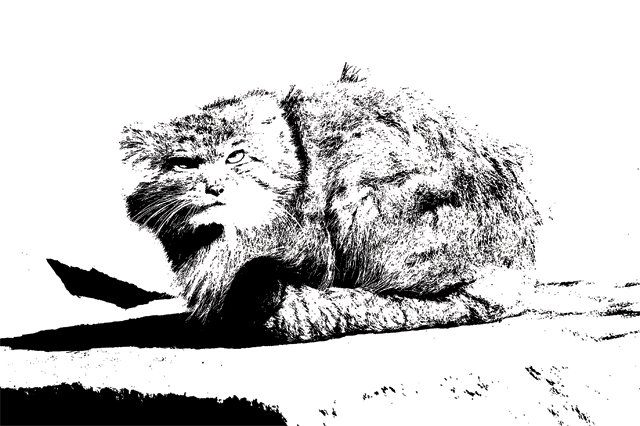The discovery of the Pallas’s cat in the Annapurna Conservation Area might be related to climate change but, at the same time, some experts believe it could actually be an indicator of a healthy ecosystem

It was a normal trip that ended with an unusual finding. In September 2012, Bikram Shrestha, the coordinator of Snow Leopard Conservancy’s Snow Leopard Scouts and Science program, led a group of students to Yak Kharka, a few hours from Manang village, to teach them about snow leopards. He set up camera traps there, as well as in other places in the Annapurna Conservation Area (ACA) -- Ladar, Praken, Manang and Aangumie Lapche--with local assistant Tashi R. Ghale, who was responsible for monitoring the device. Two months later, Shrestha received the camera trap data. It contained a small surprise; the images from Praken and Aangumie Lapche showed an unfamiliar cat species. “I was surprised because it was the size of a leopard cub but no adult snow leopard was captured with it,” says Shrestha. He was baffled because the species was very different from the other cats found in the region. A year later, cameras once again captured the strange cat in Aangumie Lapche. This time, the images were sent to several small cat specialists.
When confirmations came in, it turned out to be a species previously never thought to have existed in Nepal - a Pallas’s cat.
German naturalist Peter Simon Pallas first described the Otocolobusmanul, commonly known as the Pallas’s cat, in 1776. Also referred to simply as manul, they are commonly found in the grasslands and mountain steppes of Central Asia, with Mongolia being its stronghold. The feline is considered “Near Threatened” in the International Union for Conservation of Nature’s Red List of Threatened Species. Until it was photographed in 2012, there was no evidence of its existence in Nepal. In fact, there is no local name for the animal.
“The new pictures are significant since they come after decades of camera trap studies of snow leopards. Only now are Pallas’s cats showing up. It’s not possible for them to have been present and never photographed,” says Jim Sanderson of the Small Wild Cat Conservation Foundation, one of the specialists who confirmed the find was indeed a manul.
Although rare, these aren’t one-off incidents. In 2008, a Pallas’s cat was captured on camera in Iran. It was the first sighting of the animal in the country. A similar incident took place in Bhutan in 2012. And it’s clear that such appearances are on the rise. “This could be due to two reasons,” says Sanderson. “We either have more cameras recording wildlife, or we are seeing the impact of climate change.”
The manul mostly feeds on small rodents, birds (partridges), gerbils, hares, and marmots. Pikas, a rodent, are a favorite prey. Since pikas do not hibernate, it can be surmised that there’s sufficient food in the region. “Prey must be established before the predators,” continues Sanderson. “It’s possible that climate change has led to a change in environmental conditions that has subsequently allowed local vegetation to support small rodent populations.” Unfortunately, according to Sanderson, very little is known of small rodent communities and the vegetation they survive on because snow leopard studies usually focus on larger prey.
Small cats are not known to make great movements without food. If there is sufficient food, they will remain in the area. That appears to have been the case in the ACA as well, considering the fact that 14 images of the felines were captured in two places in as many years. While individual cats can make long distance dispersal movements, wild cats, in general, are not known to migrate. “With more records, we can conclude we are seeing a geographic range expansion,” states Sanderson. “Where there is one, there are likely more.” Since the Tibet border lies just north of the ACA, Shrestha theorizes that is where the cats came from.
A Pallas’s cat normally weighs 2.5 to 4.5 kgs, with an 18 to 26 inch long body and a tail that averages 8.3 to 12.2 inches. In short, it’s the size of a domestic cat. But is it possible for such a small feline to co-exist with much larger cats? “Yes,” answers Sanderson. “In some places, eight wild cat species can exist together. Cats are four-dimensional creatures; some are arboreal, many are terrestrial but favor one habitat over another. Some species are nocturnal, and there are others that are diurnal.”
Shrestha believes that the presence of a new species is related to the state of the ecosystem. “Snow leopards and the manul are both sympatric species, that is, they share their habitat. They coexist with thousands of other small predators and prey in the region. Since each species has a role to play, it means that the ecosystem is healthy and balanced.”
Although the presence of the Pallas’s cat in the ACA has been made official with the Snow Leopard Conservancy and the National Trust for Nature Conservation–Annapurna Conservation Area Project officially recognizing it as a new species in Nepal, there have been no plans for its conservation. While the animal has remained elusive, with no official live sightings, Shrestha thinks that a small cat that villagers in Marpha captured last year trying to kill domestic poultry might have been a manul. The fate of the animal is unknown but it is incidents like these that make long-term conservation strategies imperative for the endangered cat’s continued survival.
The discovery of the Palas’s cat means the addition of one more species to the fauna of Nepal. Given the expansive and yet-unseen effects of climate change, there might be more such sightings of other exotic wildlife in the days to come.










